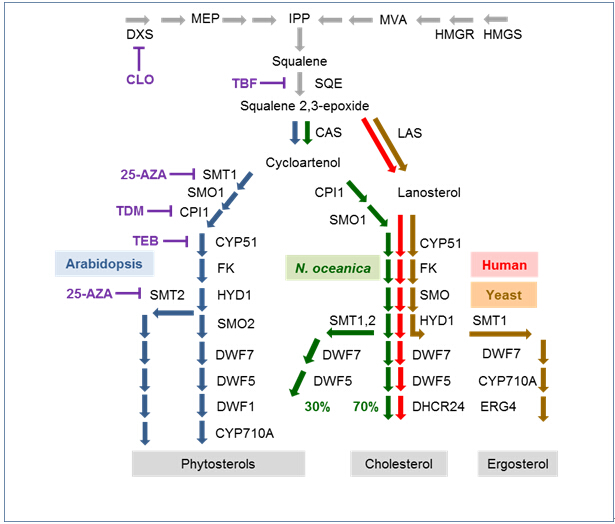中外合作发现微拟球藻合成甾醇的独特途径
中国科学院青岛生物能源与过程研究所单细胞研究中心和澳大利亚西澳大学澳大利亚研究委员会植物能源生理卓越中心合作,在微拟球藻(Nannochloropsis oceanica)中发现了独特的甾醇合成途径,在国际上率先揭示了产油微藻中甾醇合成途径和油脂合成途径关联机制,相关文章发表于2014年6月1日的《Biotechnology for Biofuels 》杂志上。

微拟球藻甾醇合成途径,及其与哺乳动物、高等植物和酵母的联系和区别
微拟球藻是一种在海洋中广泛分布,且在世界各地均可规模培养的野生高产油藻。通过比较基因组学和代谢组学分析手段,青岛能源所路延笃博士和西澳大学周文序博士等发现,微拟球藻中存在着一种与高等植物、酵母和绿藻(如莱茵衣藻)等均有显著不同的甾醇合成途径,兼具哺乳动物和高等植物特征。一方面,它既具有动物甾醇合成途径的一些特征,如富含胆固醇(占甾醇总量的~70%;高等植物中仅为1%~5%)、具备多个动物特征性的胆固醇合成关键酶(如24-脱氢胆固醇还原酶等)等。另一方面,与哺乳动物不同,它又含有少量的植物甾醇。
研究人员通过化学生物学和转录组等手段证明甾醇参与了微拟球藻的生长、光合作用、叶绿体生成和胁迫响应等关键过程,而甾醇化合物通过1-脱氧木酮糖-5-磷酸合酶(1-deoxy-D-xylulose 5-phosphate synthase,DXS)来反馈调节自身合成。同时,甾醇代谢和脂肪酸合成之间存在着协同作用机制,通过抑制甾醇合成可显著提高胞内的脂肪酸含量。结合前期揭示的缺氮条件下微拟球藻合成油脂过程的代谢网络(Li, et al, Plant Cell, 2014),该研究发现的甾醇依赖型油脂合成调控途径将为高产油藻的基因工程提供新的思路。
上述研究获得了科技部合成生物学“973”项目和中科院“能源微藻生物炼制”创新团队国际合作伙伴计划等支持,由青岛能源所单细胞研究中心徐健研究员和澳大利亚西澳大学ARC植物能源生理卓越中心Steven Smith教授合作主持完成。
原文摘要:
Yandu Lu, Wenxu Zhou, Li Wei, Jing Li, Jing Jia, Fei Li, Steven M Smith and Jian Xu
Background
Sterols are vital structural and regulatory components in eukaryotic cells; however, their biosynthetic pathways and functional roles in microalgae remain poorly understood.
Results
In the oleaginous microalga Nannochloropsis oceanica, the sterol biosynthetic pathway produces phytosterols as minor products and cholesterol as the major product. The evidence together with their deduced biosynthetic pathways suggests that N. oceanica exhibits features of both higher plants and mammals. Temporal tracking of sterol profiles and sterol-biosynthetic transcripts in response to changes in light intensity and nitrogen supply reveal that sterols play roles in cell proliferation, chloroplast differentiation, and photosynthesis. Furthermore, the dynamics of fatty acid (FA) and FA-biosynthetic transcripts upon chemical inhibitor-induced sterol depletion reveal possible co-regulation of sterol production and FA synthesis, in that the squalene epoxidase inhibitor terbinafine reduces sterol content yet significantly elevates free FA production. Thus, a feedback regulation of sterol and FA homeostasis is proposed, with the 1-deoxy-D-xylulose 5-phosphate synthase (DXS, the committed enzyme in isoprenoid and sterol biosynthesis) gene potentially subject to feedback regulation by sterols.
Conclusion
These findings reveal features of sterol function and biosynthesis in microalgae and suggest new genetic engineering or chemical biology approaches for enhanced oil production in microalgae.
作者:中科院

